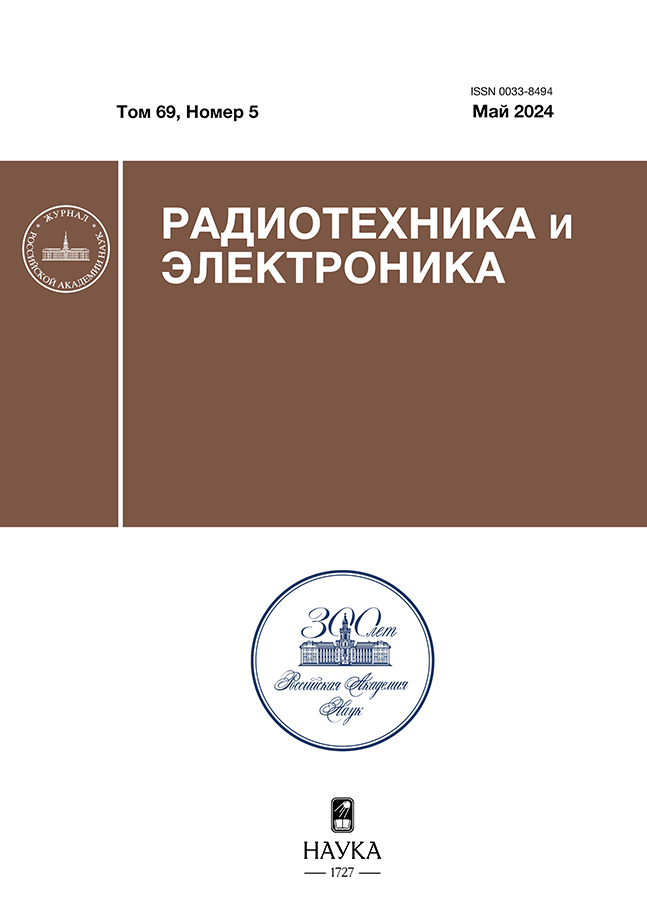Mathematical model of a signal of radar on the base of antenna array with two-dimensional frequency scanning
- 作者: Bankov S.E.1, Komarov A.A.1, Mikhailov M.S.1
-
隶属关系:
- Kotelnikov’s Institute of Radio Engineering and Electronics
- 期: 卷 69, 编号 5 (2024)
- 页面: 403-413
- 栏目: ELECTRODYNAMICS AND RADIO WAVE PROPAGATION
- URL: https://kazanmedjournal.ru/0033-8494/article/view/650670
- DOI: https://doi.org/10.31857/S0033849424050012
- EDN: https://elibrary.ru/ILSOQV
- ID: 650670
如何引用文章
详细
An antenna array with series excitation and its application as part of a radar with linear frequency modulation are considered. An analysis of an array consisting of Na parallel one-dimensional sub-arrays with series excitation forming a two-dimensional radiating array and coupling waveguides connecting the output of the n-th sub-array with the input of n+1 sub-array through 180° waveguide turns is presented. An approximate model of the antenna is proposed, which makes it possible to determine its main technical characteristics. Using the developed model, the time characteristics of the signal at the output of an ultrahigh frequency unit of a homodyne radar with linear frequency modulation are investigated. The dependences of the array quality indicators on the scattering parameters of elementary radiators and waveguide 180° turns are analyzed, and the technical requirements for them are formulated. It is shown that the radar provides scanning in the sector of azimuth angles ± 40° and ± 10° in the elevation with a frequency deviation in the 2 GHz band.
全文:
作者简介
S. Bankov
Kotelnikov’s Institute of Radio Engineering and Electronics
编辑信件的主要联系方式.
Email: sbankov@yandex.ru
俄罗斯联邦, Mokhovaya str, 11, bild. 7, Moscow, 125000
A. Komarov
Kotelnikov’s Institute of Radio Engineering and Electronics
Email: sbankov@yandex.ru
俄罗斯联邦, Mokhovaya str, 11, bild. 7, Moscow, 125000
M. Mikhailov
Kotelnikov’s Institute of Radio Engineering and Electronics
Email: sbankov@yandex.ru
俄罗斯联邦, Mokhovaya str, 11, bild. 7, Moscow, 125000
参考
- Банков С.Е. Антенные решетки с последовательным питанием. М.: Физматлит, 2013.
- Stegen R.J. // Trans. IRE Professional Group on Antennas and Propagation. 1952. V. 1. № 1. P. 62.
- Rotman W., Oliner A.A. // IRE Trans. 1959. V. MTT-7. № 1. P. 134.
- McCormick G. // IRE Trans. 1958. V. AP-6. № 1. P. 26.
- Rotman W. // IRE Trans. 1958. V. AP-6. № 1. Р. 96.
- Ettorre M., Sauleau R., Le Coq L., Bodereau F. // IEEE Trans. 2014. V. AP-62. № 14. P. 1991.
- Cheng Н., Hong W., Wu K. et al. // IEEE Trans. 2008. V. AP-56. № 9. P. 3055.
- Albani M., Ettorre M., Maci S. et al. // Euroр. Conf. on Antennas and Propagation (EuCAP) 2007. Edinburgh. 11–16 Nov. 2007. N.Y.: IEEE, 2007. Article No. 445897. http://ieeexplore.ieee.org/xpls/abs_all.jsp?arnumber=4458971
- Хансен Р.С. Сканирующие антенны СВЧ. М.: Сов. радио, 1971. Т. 3.
- Банков С.Е., Фролова Е.В. // РЭ. 2017. Т. 62. № 9. С. 833.
- Елисеев С.Е., Гусевский В.И., Терехов В.А. и др. Радиолокационная система ближнего действия для предупреждения столкновения с препятствиями маневрирующих на аэродроме летательных аппаратов Пат. РФ № 2192653. Опубл. офиц. бюл. “Изобретения. Полезные модели” № 31 от 10.11.2002.
- Баскаков А.И., Жутяева Т.С., Лукашенко Ю.И. Локационные методы исследования объектов и сред. М.: ИЦ “Академия”, 2011.
- Проектирование фазированных антенных решеток / Под ред. Д.И. Воскресенского. М.: Радиотехника, 2012.
- Сазонов Д.М. Антенны и устройства СВЧ. М.: Высш. школа, 1988.
- Уолтер К. Антенны бегущей волны. М.: Энергия, 1970.
补充文件




















